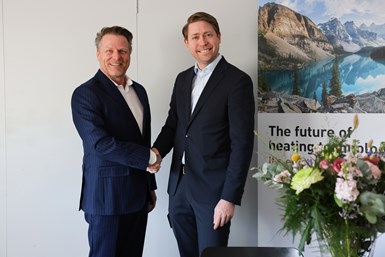Kanthal, Rath Partner to Expand Sustainable Industrial Heating Offerings
Kanthal and Rath are partnering to expand combined offerings in industrial heating technology. Through this collaboration, the companies hope to enable industries to make the “green shift.”
#sustainability
Edited by

Rath CSO/CFO Andreas Pfneiszl (left) and Kanthal President Robert Stål (right). Photo Credit: Kanthal
The partnership between Kanthal and Rath aims to bring together the strengths of both companies, creating a range of sustainable industrial heating solutions. Kanthal’s experience in heating elements and systems combined with Rath’s insulation and refractory products intends to provide customers with a unique combined offering for their industrial heating needs.
“We are thrilled to partner with Rath to further expand our offerings in industrial heating technology, enabling societies and industries to make the green shift,” says Robert Stål, president of Kanthal. “In this era of electrification, this partnership will provide our customers with a broader range of innovative solutions that will enable them to optimize their operations and achieve their sustainability goals.”
Together, the companies aim to leverage their collective expertise to deliver greater value to their customers and help them thrive in a rapidly evolving market.
“For quite some time, we have been focusing on sustainability in all our activities — be it when it comes to developing energy-saving refractory products or, more specifically, refractory materials that can be used to line electrically heated furnaces,” says Andreas Pfneiszl, CFO/CSO of Rath. “With the latter, we will — together with our strategic partner Kanthal — enable customers’ shifts toward fossil fuel-free production.”
Through closer collaboration in developing technologies and solutions, the partnership aims to leverage both companies’ existing and future co-developed offerings to enable the technology shift that industries, such as steel and petrochemical, are facing. The companies’ joint go-to-market model offers customers a portfolio of products and services, providing greater value and convenience to clients.
RELATED CONTENT
-
Axalta Receives International Sustainability and Carbon Certification Plus
This milestone further reinforces Axalta’s commitment to ensuring sustainability remains central to every part of its business.
-
AkzoNobel Powder Coatings Partners With CoatingAI
The partnership aims to explore possibilities with sustainability, including the development of Flightpath.
-
Interpon Helps Aluminum Coating Business with Sustainability
DFV is partnering with AkzoNobel Powder Coatings to keep the business out in front by using an Interpon powder coating technology that can make aluminum look like wood.
















